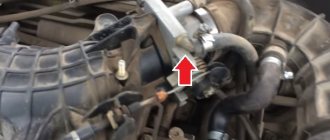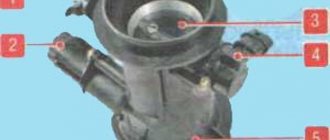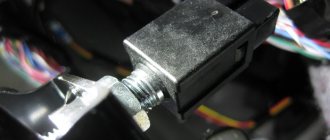All modern cars are equipped with an electrically operated throttle valve. Instead of the usual cable. What is the difference between an electronic throttle and a mechanical one?
The electronic throttle valve is controlled by the KSUD unit (engine management system controller). The opening and closing of the valve is driven by an electric motor built into the throttle body.
How does the Lada Vesta electric throttle work at idle speed?
The electronic throttle of the Lada Vesta does not have a separate IAC (idle speed regulator), which was installed in the mechanical throttle. Idle speed in the electronic throttle is controlled by the main damper; it opens the cross-section of the throttle pipe exactly as much air as the engine needs to operate at idle speed.
The controller controls the crankshaft speed at idle speed. The actuator that meteres the incoming air into the engine is the throttle valve, the opening angle of which at idle is set by the controller depending on the temperature of the coolant, the consumers turned on (air conditioning, seat heating, fan, etc.) In addition, to maintain the idle speed, the controller controls OZ and fuel supply. It is worth remembering that when driving a car with the accelerator pedal released in 1st, 2nd or 3rd gear, the specified idle speed differs from the specified speed of a stationary vehicle and depends on the temperature of the engine coolant. The state of the engine at idle speed can be determined by the parameters of the current idling correction, (“Desired change in torque to maintain idle speed (integral part)”% and the desired change in torque to maintain idle speed (proportional part)”%) and the torque adaptation parameter (“ Idle speed adjustment adaptation parameter "%). The torque adaptation parameter is determined only on a warm engine, but is used as an additive throughout the entire temperature range of engine operation.
Brakes: TRW brand, made in the Czech Republic, Poland, Italy, France, Turkey
In order for the Lada Vesta to stop properly, manufacturers from almost half of Europe had to work hard. In total, we counted five countries producing the braking system, including French SNR bearings pressed into the rear brake drums (integrated with the hub) of the German ATE brand, but of Italian production. When it is necessary to replace the bearing, it will be extremely difficult to remove it separately - most likely, you will have to change the entire assembly. Although the name of the SNR brand, which is premium by the standards of the world of auto components, inspires hope for durability.
So, the brake master cylinder and vacuum booster came from Poland, the front calipers and pads came from the Czech Republic. Some of the brake hoses turned out to be made in Turkey by Teklas. One of the features is that there is one brake system reservoir for two with a clutch drive.
The only question regarding the brakes arose when considering the front pads, on which there was a working mark of the cylinder - a quarter of the pressing surface extends beyond the pads. It is difficult to say whether this somehow affects the braking efficiency. While driving, we had no complaints about the braking system.
You will also have to tinker with the suspension elements during repairs. According to “foreign” patterns, the ball (produced by the BelMag Magnitogorsk plant) comes assembled with a lever. Moreover, replacing a component will require a lot of additional actions to free up space around it. By the way, according to servicemen, play of ball joints and knocking of stabilizer struts are the most frequent complaints from the first owners of Vesta.
Shock absorbers are one of the few Vesta components on which we did not see the “Aglitsky language”. The racks were produced at the Skopinsky Automotive Assembly Plant in the Ryazan region. By the way, in terms of the balance of suspension characteristics, we recognize Vesta as one of the best in the class.
Electric throttle of Lada Vesta when pressing the gas sharply.
The interaction takes place between the electronic accelerator pedal, the engine control unit and the electronic throttle valve.
To reduce engine load and fuel consumption when driving. If you sharply press the gas pedal to the floor, the throttle will not open completely, as it did with a cable drive, but will open smoothly in accordance with the tachometer speed. That is, protection from fools. If you drive 40 km/h in fourth gear and press the gas pedal to the floor, the electronic throttle will not open 100% and will not put more load on the engine. Thus, the car will not accelerate, but will force the driver to switch to a lower gear.
The clutch and brake pedals have sensors that are activated when the pedals are pressed.
Superficial intervention or deep cleaning?
There are two ways to clean the throttle valve. The first is a superficial intervention that does not require complete removal of the entire device. And the second is a complete cleaning, which must be performed in cases where your car’s engine is not working well.
To perform the first type of cleaning, you will need a pre-purchased cleaning product and a fine brush. Open the hood, remove the corrugation, it goes from the air filter housing to the throttle valve. You will see a valve - it is easy to recognize by its completely round shape. Treat it with a chemical and let it sit for a few minutes, then remove the dirt with a brush. If necessary, use a rag. Repeat the procedure several more times until the flapper valve turns a bright color. This work can be carried out once every 3–5 thousand kilometers, fortunately, it does not take much time.
For more detailed cleaning of the throttle valve in a VAZ 2110, you need to completely remove the entire injector mechanism. It is also recommended to replace the gasket and O-ring, which are included in the throttle valve repair kit, which is easy to buy at any auto store. Before starting cleaning work, remove the terminals from the battery.
Then disconnect all air pipes connected to the throttle body. After this, remove the fastenings of the throttle cable and unscrew the throttle valve itself. It is attached to two bolts that are screwed into the engine housing.
Electronic sensors must be disconnected carefully to avoid damaging them.
After that, take a chemical and treat the entire body and all the grooves of the throttle body. Do this until you completely get rid of the dirt. You can also clean the air flow meter sensor. To do this, carefully treat its hairs with a cleaning product and remove the dirt with a brush. Give the entire device time to dry completely before reassembling. Do not forget to change the gasket and ring, which are located in the corrugation
Also pay attention to whether all air pipes are intact. Perhaps some require replacement with new ones
For maximum effect, you can also replace the air filter.
Lada Vesta brake sensor and what is the connection with the electronic throttle.
If the electronic engine unit sees from the speed sensor that the car is moving and not standing still. In this case, the brake pedal is released, the throttle valve operates normally, but as soon as the driver presses the brake pedal, the electronic unit will immediately give a command to close the throttle valve so that engine braking occurs.
This is such a smart unit, this electric throttle!
Engine sensors Renault K4M 1.6 16V
A wide range of Renault models are equipped with a 1.6 liter K4M engine. This power unit has been installed since 1999; it is found on Megane 2, Clio II, Logan and other models. The engine has a sixteen-valve cylinder head, two lightweight camshafts, an updated piston group, and hydraulic compensators, which allows you to obtain more power without sacrificing the endurance and reliability of the engine. Failures of this engine are rare; they are signaled by sensors that monitor its condition. The following sensors are involved in the operation of the Renault K4M 1.6 16 valve engine:
- crankshaft sensor;
- absolute pressure sensor (vacuum sensor);
- intake air temperature sensor;
- knock sensor;
- coolant temperature sensor;
- camshaft sensor;
- phase regulator valve;
- fuel tank purge valve;
- oxygen sensors;
- gas pedal and throttle sensor.
You can view the status of all the above sensors and diagnose their malfunction using the Rokodil ScanX scanner.
In combination with the Car Scanner program, the device is capable of displaying more than 20 K4M performance parameters, including: exhaust gas system diagnostics, status of all sensors, throttle opening percentage, ignition timing and much more. It is also worth noting that the device is multi-brand and is suitable for use with other engines of domestic and foreign production.
Electronic throttle device for Lada Vesta.
The electronic throttle system uses two throttle position sensors. TPS are part of the electrically driven throttle valve.
The TPS is a potentiometric type resistor, one of the terminals of which is supplied with a reference voltage (5 V) from the controller, and the second is supplied with ground from the controller. From the pin connected to the moving contact of the potentiometer, the TPS output signal is supplied to the controller. The controller controls the position of the throttle valve electrically, in accordance with the position of the accelerator pedal. Based on the TPS readings, the controller monitors the position of the throttle valve.
Absolute pressure sensor (vacuum sensor)
The absolute pressure sensor is located on the intake manifold and is designed to read vacuum. When the engine is warm, it shows values of the order of 300-400 mbar. When the engine is turned off, the sensor should show an atmospheric pressure of about 1021 mbar.
If this sensor fails, Renault either does not start or does so with great problems. In this case, with the engine turned off, the sensor produces 300-400 mbar, which means it is stuck in the working position. If the engine does start, then with sharp acceleration it choke, accelerating very poorly.
Position of the Lada Vesta electronic throttle when starting the engine.
When the ignition is turned on, the controller sets the damper to the pre-start position, the degree of opening of which depends on the coolant temperature. In the pre-start position of the throttle valve, the output signal of TPS 1 should be within 0.58...0.70 V, the output signal of TPS 2 within 4.30...4.42 V. If you do not start the engine within 15 seconds and do not press the pedal accelerator, the controller de-energizes the electric throttle drive and the throttle valve is set to the 6-7% throttle opening position.
In the de-energized state (LIMPHOME) of the electric throttle valve drive, the output signal of TPS 1 is within 0.70...0.75 V, the output signal of TPS 2 is within 4.25...4.30 V. Further, if no action is taken for 15 seconds the check (“learning”) mode will begin 0 - the throttle valve position is completely closed and the throttle valve opens to the pre-start position, and then the electric throttle valve drive will again switch to de-energized mode.
At any throttle position, the sum of the TPS 1 and TPS 2 signals should be equal to (5±0.1) V. If a fault occurs in the TPS circuits, the controller de-energizes the electric throttle drive, stores its code in its memory and turns on the alarm. In this case, the throttle valve is set to the 6-7% throttle opening position.
When and how to do it yourself
When to do it
adaptation of the throttle valve zero and adaptation of the misfire diagnostic function:
- After replacing the ECU controller or resetting the controller using a scan tool.
- After replacing the throttle assembly.
Throttle zero adaptation procedure
:
- When the car is stationary, you must turn on the ignition, wait 30 seconds, turn off the ignition, wait until the main relay turns off.
Adaptation will be interrupted
, If:
- the engine turns over;
- the car is moving;
- the accelerator pedal is pressed;
- engine temperature is below 5 °C or above 100 °C;
- Ambient temperature is below 5 °C.
Adaptation procedure
Misfire diagnostic functions:
- warm up the engine to operating temperature (parameter value “Coolant temperature” = 60.90 °C);
- accelerate the car in 2nd gear until higher crankshaft speeds are reached (parameter value “Engine crankshaft speed” = 4000 min-1) and perform engine braking (“Engine crankshaft speed” = 1000 min-1);
- Perform engine braking six times in one trip.
The adaptation procedure is specified in the technological instructions (TI 3100.25100.12056) for Lada Vesta (download) and XRAY (download).
How to adapt and train the electronic throttle of Lada Vesta.
If the electronic throttle body or ECM is replaced, or the controller is reset using the scan tool (Function Test; ECU Reset with Initialization mode), the Throttle Zero Adaptation procedure must be performed.
To do this, with the car standing, you need to turn on the ignition, wait 30 seconds, turn off the ignition, and wait until the main relay turns off.
Adaptation will be interrupted if:
- the engine turns over;
- the car is moving;
- the accelerator pedal is pressed;
- engine temperature is below 5 °C or above 100 °C;
- Ambient temperature is below 5 °C.
If the electric throttle actuator is de-energized, the throttle valve is held in the Limp home position (6-7%) using direct and return springs.
Need for maintenance
The prophylaxis procedure should not be carried out in the absence of obvious reasons. Before starting, you need to carefully evaluate the condition of the throttle valve. If there are no obvious signs of tar deposits and areas of coking, then the reason for unstable operation may lie elsewhere.
Also consider the mileage of the car. Experts recommend resorting to flushing no earlier than after 100 thousand km. But on some cars, for example, a Ford Focus, it may be necessary to flush it after 30 thousand kilometers.
You should know how to clean your throttle body to achieve the desired result. This requires a special carburetor cleaning solution, for example, Abro Carb & Choke Cleaner or similar products. The assembly must be dismantled; only in this case can the maximum effect be achieved, otherwise carbon deposits will remain inside the tubes. Disconnect all pipes from the throttle valve to gain good access to the inlet part of the assembly.
Remove carbon deposits delicately using a clean rag or soft brush. Do not use excessive force; you may damage the valve. The internal elements are coated with a thin layer of molybdenum, which novice car enthusiasts mistake for harmful deposits.
The consequences of zealous cleaning can be different: the moving part of the damper will begin to bite, or vice versa, in the closed position it will begin to let air through. In this case, it will not be possible to do without repairing the throttle valve.
Code P0122 Low signal level of the Lada Vesta throttle position sensor.
Code P0122 is entered if:
- ignition on;
- the throttle position sensor signal voltage (ADC parameter “ Throttle sensor voltage 1 ”) is less than 0.25 V for 0.12 s.
The malfunction indicator lights up 5 s after the fault code appears.
Description of checks.
The sequence corresponds to the numbers on the card.
- Using a diagnostic tool, it is checked whether code P0122 is active at the time of diagnosis. If only code P0122 is detected, then the fault must be looked for in the signal circuit of TPS A. If codes P0122 and P0222 are detected at the same time, then the fault must be looked for in the power circuit of TPS A and TPS B.
- The circuit is checked from contact “X1.2/G2” of the controller to contact “3” of the electronic protection device.
- The controller is checked: when you bridge contacts “3” and “5” of the block to the EDS using a probe, the TPS A signal on the diagnostic device should change.
- The circuit is checked from contact “X1.2/E3” of the controller to contact “5” of the electronic protection device.
- The controller is checked: pin “5” of the block to the EDS should receive a reference voltage of 5 V from the controller.
Causes
The most common reason for an adaptation to be made is the consequences of throttle valve maintenance. As a result of operation, a large amount of deposits forms in this unit, therefore, after flushing, the position of the throttle valve changes, and the ECU continues to send signals about its condition until maintenance.
Over time, natural wear occurs on the resistive layer of the sensor potentiometer and the moving elements of the throttle valve; in this case, after adaptation, it will most often require replacement. It is necessary to conduct training if changes are made to the ECU settings (chip tuning), especially if operations have been performed to increase engine power.
The procedure is performed using special programs on computer equipment or without them (a strictly defined procedure, which will be discussed below) depending on the brand of car. Auto electricians must take into account the features of the model, year of manufacture, and type of ECU installed on the vehicle.
Diagnostic information on the electronic throttle valve of Lada Vesta.
If a fault is detected in the TPS A circuit, the engine control system will operate in emergency mode until the end of the current trip.
The following emergency modes are possible: - limiting engine power if the TPS B circuit is working; — de-energizing the electric throttle drive and limiting engine speed (2500 rpm) if the TPS-A and TPS-B circuits are faulty.
The diagnostic tool in the “Signal Monitoring” mode displays the signals TPS A (ADC parameter “Throttle sensor voltage 1” ) and TPS B (ADC parameter “Throttle sensor voltage 2” ) in volts.
When the throttle valve is opened, the TPS A signal increases, the TPS B signal decreases.
With the throttle valve fully closed, the TPS A signal should be in the range of 0.30…0.58 v, the TPS B signal should be in the range of 4.42…4.70 v. The sum of the TPS A and TPS B signals should be equal to (5±0.1) V at any throttle position.
Knock sensor
The knock sensor of the Renault K4M 1.6 16 V engine located on the front of the cylinder block is used to monitor misfires caused by detonation. Using this sensor, the ignition timing is adjusted. It can be determined that it has failed only by the presence of an error monitored by the ECU and displayed on the dashboard and scanner. At the same time, the thrust will decrease slightly and the consumption will increase.
A mechanical failure occurred with the owner of a Lada Vesta.
I drove for a little while after buying the car and during kickdown the car did not pick up speed and went into emergency mode, to which an acquaintance of the former owner said it was drizzling, the ABS sensor took my word for it, but in vain. And at 130,000 km I was already forced to urgently go to the service center to look for the fault; in the end, the reason turned out to be in the throttle valve because... Manufacturers made plastic gears on them and over time they ground down and broke off in some places.
SUBSCRIBE TO NEW ARTICLES VIA VK GROUP!
Subscribe
Salon
Those who have driven Vesta for a relatively long time have known that the front-wheel drive family is characterized by rattling interiors, squeaks in the cabin, and they also break quickly. The steering wheel covers are also flimsy - the paint peels off too quickly. Developers have been struggling with these problems for quite a long time, starting from the time of Kalina. In the second generation, they began to apply solutions to reduce interior parts and began to attach them better. Thus, Vesta’s evolution continues, but problems of this nature do not completely disappear.
To this day, owners continue to complain about squeaks. AvtoVAZ promises to fix all problems by:
— changes in fastenings of interior parts;
— change of the dashboard;
— central console.
Coolant temperature sensor
It is located in the thermostat housing; before 2006 it was screwed in, but after that it is inserted using brackets and latches. Its indicators must match on the dashboard and scanner. The operating temperature of the 1.6-liter K4M engine is +90°C; if the sensor fails, then at factory the machine goes into -40°C mode, and the fan begins to operate in emergency mode. The fan turning on at startup is one of the signs that the coolant temperature sensor is faulty.
Camshaft sensor
It is located in the cylinder head and is responsible for monitoring the rotation speed and camshaft position. In the K4M Renault engine, an error quite often appears on this sensor, but its failure does not affect the operation of the engine. After identifying it using a scanner, no other problems are observed in the operating parameters of the engine. The thrust remains at the same level, the engine does not overheat, fuel consumption remains normal.
Oxygen sensors
One is located in the exhaust manifold, located for the catalyst (upper sensor). Its failure leads to increased or unstable speed, decreased traction and other problems in engine operation.
When diagnosing, you need to pay attention to the temperature of the upper oxygen sensor, which is equipped with a spiral. It gets hot when starting up. The millivolt value should be between 100 and 800 mV. The heating of the upper sensor must be active; when the spiral burns out, an open circuit occurs, the ECU generates an error and starts the engine in average or emergency mode.
The solution to the problem is to replace the lambda probe. The lower sensor acts as a diagnostic sensor and signals the condition of the catalyst. If it is torn, this does not affect the operation of the engine as a whole, but can lead to failure of the catalyst.











